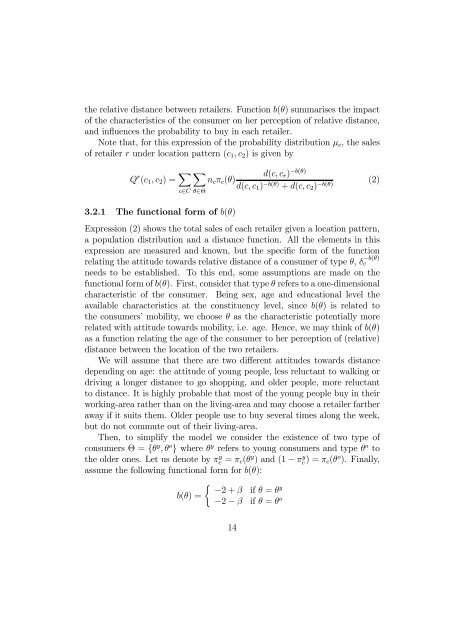Download PDF - Ivie
Create successful ePaper yourself
Turn your PDF publications into a flip-book with our unique Google optimized e-Paper software.
the relative distance between retailers. Function b(θ) summarisestheimpact<br />
of the characteristics of the consumer on her perception of relative distance,<br />
and influences the probability to buy in each retailer.<br />
Note that, for this expression of the probability distribution µ c ,thesales<br />
of retailer r under location pattern (c 1 ,c 2 )isgivenby<br />
Q r (c 1 ,c 2 )= <br />
d(c, c r ) −b(θ)<br />
n c π c (θ)<br />
(2)<br />
d(c, c<br />
c∈C<br />
1 ) −b(θ) + d(c, c 2 ) −b(θ)<br />
θ∈Θ<br />
3.2.1 The functional form of b(θ)<br />
Expression (2) shows the total sales of each retailer given a location pattern,<br />
a population distribution and a distance function. All the elements in this<br />
expression are measured and known, but the specific form of the function<br />
relating the attitude towards relative distance of a consumer of type θ, δc<br />
−b(θ)<br />
needs to be established. To this end, some assumptions are made on the<br />
functional form of b(θ). First, consider that type θ refers to a one-dimensional<br />
characteristic of the consumer. Being sex, age and educational level the<br />
available characteristics at the constituency level, since b(θ) isrelatedto<br />
the consumers’ mobility, we choose θ as the characteristic potentially more<br />
related with attitude towards mobility, i.e. age. Hence, we may think of b(θ)<br />
as a function relating the age of the consumer to her perception of (relative)<br />
distance between the location of the two retailers.<br />
We will assume that there are two different attitudes towards distance<br />
depending on age: the attitude of young people, less reluctant to walking or<br />
driving a longer distance to go shopping, and older people, more reluctant<br />
to distance. It is highly probable that most of the young people buy in their<br />
working-area rather than on the living-area and may choose a retailer farther<br />
away if it suits them. Older people use to buy several times along the week,<br />
but do not commute out of their living-area.<br />
Then, to simplify the model we consider the existence of two type of<br />
consumers Θ = {θ y , θ o } where θ y refers to young consumers and type θ o to<br />
the older ones. Let us denote by πc y = π c (θ y )and(1− πc y )=π c (θ o ). Finally,<br />
assume the following functional form for b(θ):<br />
−2+β<br />
b(θ) =<br />
−2 − β<br />
if θ = θ<br />
y<br />
if θ = θ o<br />
14
















